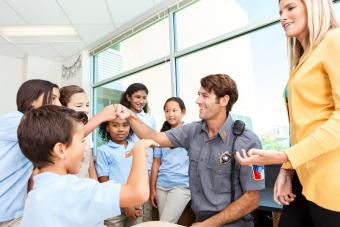
Human beings are all incredibly unique, so it's no great surprise that people learn differently. What works for one child doesn't necessarily work for the next. While the information people receive might be the same, how humans best process that information differs with regard to several factors, including their learning style. Know what learning style best suits your child, so no matter the subject or the topic, they can access information easily and efficiently, via their preferred learning method.
Seven Recognized Learning Styles
There are now seven recognized styles of learning, and most learners gravitate towards some combination of these styles, not solely one way of learning. Knowing a person's learning style and how to apply it to the real world can help them be the very best learner they can be.
Visual Learning Style
Visual learners rely heavily on what they see. They gravitate towards pictures and images, maps and graphs. Aside from gathering information best with the use of their eyes, they also prefer to draw and write out information. Colors and shapes are tools that visual learners rely on to help them sort and organize the information they are working towards retaining.

Characteristics of a Visual Learner
Visual learners often possess common characteristics that set them apart from groups of other learners. These learners tend to:
- Draw, doodle and sketch as a means of organizing their thinking
- Appear watchful and observant to the person disseminating the information
- Be attentive and not easily distracted
- Prefer the directions in written form
- Take in color-coding information
Learning Strategies to Help Your Visual Learner
If you have a visual learner at home or in class, there are certain activities you can incorporate into their learning to help them interpret information as best they can.
- If working within a classroom, place visual learners towards the front of the classroom closest to the written information.
- Utilize maps, graphs, charts, and other visual representations of information.
- Break written information into color-coded sections.
- Older children can use colored highlighters to sort information.
- Flashcards are helpful tools for visual learners.
Kinesthetic Learning Style
Kinesthetic learners, also called tactile learners, are the ones who love to move about and touch things. They experience information by physically engaging with it. They touch, manipulate, and move items about to best learn the concepts being taught. These hands-on learners make up five percent of the population.

Characteristics of Kinesthetic Learners
These learners are on the go, so you might notice them moving about more compared to other types of learners. Tactile learners:
- Choose to work with their hands
- Exhibit physical energy with their body parts (They wiggle their leg, drum their fingers, and stretch their body parts).
- Often have outgoing and engaging personality traits
- Tend to touch the surfaces and objects around them
Learning Strategies to Help Your Kinesthetic Learner
If you want to help your mover and shaker learn something, some strategies are specifically designed to reach kinesthetic learners.
- Keep learning areas free of clutter, as these learners tend to fidget and explore even irrelevant materials nearby.
- Provide opportunities for learning breaks where children can move about freely.
- Allow for modes of learning where sitting is not required.
- Use manipulatives in learning.
- Create opportunities for role-playing when possible.
- Utilize art projects, word tracing with fingers, clapping out syllables when teaching literacy lessons.
- Create puppet shows to combine movement, art, and information.
Aural Learning Style
Aural or auditory-musical learners prefer to hear information over seeing or physically manipulating it. They often have an aptitude for music, and are the kids you catch humming or repeating information back to themselves.

Characteristics of Aural Learners
Aside from humming to themselves or repeating information, aural learners display some of the following qualities and characteristics:
- Can be easily distracted, especially by background noises
- Eloquent
- Possess an aptitude for storytelling
- Tend to recall names over faces
- Frequently talk to themselves
- Have an ability to key into tone, melody, rhythm, and anything else related to music
Learning Strategies to Help Your Aural Learner
Aural learners, or auditory learners, will absorb information that is spoken or sung aloud. Incorporate learning and study strategies that focus on sound instead of visuals.
- Give directions and test questions orally, or pair written information with spoken information.
- Be sure these learners are close to any speakers.
- Create rhymes and songs to learn new information.
- Record lessons that are verbally spoken, so aural learners can play back the recording.
- Read aloud when possible.
Social Learning Style
These kids are all about group situations! They prefer to work with others instead of learning in a solitary manner. Many social learners have leadership qualities, but others do not possess this trait. A misconception is that these kids are highly social beings and extroverted. The learning style is not necessarily associated with being an extrovert or being a social person. Rather, it highlights the environment kids learn best in. You can be an introverted learner, but retain information best in a group setting where information is shared and/or worked out as you listen.

Characteristics of Social Learners
Those considered social learners, or interpersonal learners, prefer social settings over independent work. They might be outgoing or otherwise. Regardless, they choose to hear and absorb information in group settings. People with this learning style are often:
- Good communicators
- Empathetic in nature
- Good listeners
- Make friends and maintain social relationships easily
Learning Strategies to Help Your Social Learner
Recall that social learners can be social beings ready to share aloud and communicate with group members verbally, or they can be more introverted and take information in by listening to their peers in a group setting. Because of this, strategies for social learners can vary, and what works with one type of social learner might not benefit another. These learners especially need many modes of learning incorporated into activities, but the common factor is the environment. The learning environment remains a social one.
- Create groups when working problems out or discussing topics of learning.
- Allow for study sessions in pairs.
- Allow for groups to include speaking and listening opportunities.
- Create several roles within groups to accommodate various types of social learners.
- Have whole-class discussions where students can share verbally or listen to classmates' ideas.
- If working with a social learner at home, engage in discussions, play interactive games, utilize technology to connect with likeminded peers and learners.
Solitary Learning Style
Solitary learners prefer to learn independently of others. They can also be visual, auditory, physical, verbal, or logical learners. This type of learner does a lot of thinking and processing between their ears. Anyone overseeing their education will need to have the means to check in and ensure information is being processed correctly.

Characteristics of Solitary Learners
Solitary learners have a learning style that allows them to learn information independent of other people. They often have characteristics like:
- Enjoying activities that can be done alone, such as journaling, drawing, and reading
- Independent nature
- Goal-oriented
- Planners
- Introspective
Learning Strategies to Help Your Solitary Learner
When working with solitary learners, connect with them by checking in to ensure they are retaining the information you are teaching.
- Provide quiet space for these learners to work.
- Have means of checking in via auditory or written work, so you can ensure learning is occurring.
- Give them time and warning before engaging in a verbal check-up session.
- Give various opportunities for them to share their learning with you. This can be through discussion, art, design, or written work. Solitary learners can gravitate towards other modes of learning (visual, auditory, otherwise).
- Have them keep notebooks of their work and their thinking so you can review it.
- Create opportunities to combine solitary learning with a more challenging learning mode (perhaps something social). Do a book talk where you and the solitary learner read a chapter independently and then have a brief discussion on the matter. This allows them to play to their strength and pushes them to try something different.
Verbal Learning Style
Verbal learners respond to spoken information. They adore discussion and debate and communicate via speaking and writing.

Characteristics of Verbal Learners
Verbal learners are word wonders. By nature, they tend to:
- Use words and discussion
- Have a large vocabulary
- Be conversational
- Be social and engaging
Learning Strategies to Help Your Verbal Learners
Kids who have a strong verbal learning style might benefit from activities where they can let their penchant for words shine.
- Use discussion, debate, and role-playing
- Play word games, use rhymes, acronyms, and pneumonic devices
- Read aloud with learners
- Read their writing aloud
Logical Learning Style
Logical learners like concrete answers. Because of the need for black and white, they tend to gravitate to math and science-based subjects. While a strong suit in logic is an asset, it can be key to help these learners lean into other subjects that might not come as easily to them.

Characteristics of Logical Learners
Logical learners are ones who like absolutes. They appreciate answers to their inquiries, especially closed-ended ones that give them closure to questions. These learners:
- Have a black and white nature
- Enjoy subjects that allow for concrete endings and answers
- Prefer realistic subject matters over fiction
- Gravitate toward closed-ended questions
- Are investigative
- Enjoy rules, steps, and procedures
Learning Strategies to Help Your Logical Learners
To help these students expand their learning and acquire knowledge and confidence in areas that do not come easily to them:
- Work on subject matters in literacy and art.
- Utilize fictional material.
- Use open-ended questions that allow for discussion and dialogue.
- Have them verbalize ideas and answers.
- Work on creative writing assignments (often out of their comfort zone).
- Discuss big picture ideas (another challenge for learners who are strong in the logic realm).
The Limitations of Learning Styles
Recent research has concluded that teaching children to use one specific learning style isn't as beneficial in the long run as was initially thought. Sticking to what you perceive as your preferred learning style can create limitations for individuals, giving them a false belief that they cannot learn in a way that is not their preferred learning style. Educators and parents can still keep learning styles in mind, but it is always best to give human beings information in several ways, so they may access it using a multitude of methods and senses.
Above All, Create a Love of Learning
You can have the very best idea of preferred learning styles, excellent dissemination of subject matter, wonderful activities and ideas to help students engage, and the very best materials money can buy, but that will not get you far if kids don't develop a love of learning. Teach students that learning is fun, exciting, and full of possibilities from a young age. A love of knowledge, motivation, and the desire to learn will get any child far in life, regardless of their learning style.







